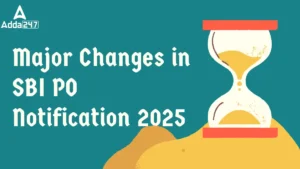Dear Aspirants,
Reasoning Questions for SBI PO Prelims 2018 (Week-05)
Reasoning Ability is an onerous section. With the increasing complexity of questions, it becomes hard for one to give it a cold shoulder. The only way to make the grade in this particular section in the forthcoming SBI PO Prelims and other banking exams is to practice continuously with all your heart and soul. And, to let you practice with the best of latest pattern questions, here is the Adda247 Reasoning Quiz with the exact same pattern of questions that are being asked in the exams.
Following the study plan for SBI PO Preliminary Examination 2018, the third week starts with practice questions on Puzzles & Seating Arrangement and Syllogism. To ensure proper preparation of the section we advise you to go through all the questions sincerely and try to attempt each one of them. Afterward, match your solutions and the approach with the one that would be provided later. Practice more and more questions on the same section to enhance your grip over the topics. Following is the Reasoning Ability quiz to help you practice with the best of latest pattern questions.
Directions (1-5): Study the following information carefully and answer the questions given below:
Seven persons, namely A, B, C, D, E, F and G will appear for a different exam but not necessarily in the same order, in seven different months (of the same year) namely January, February, April, May, July, September and December. Each of them also like different phones viz. MI, Redmi, Moto, Oppo, Oneplus, Vivo and Apple but not necessarily in the same order.
D will appear for an exam in a month which has only 30 days. Only one person will appear between the one who likes Oneplus and D. The one who likes Redmi will appear for an exam immediately before the one who likes Oneplus. The one who likes Apple will appear for an exam neither in the month which has 31 days nor in the month which has 30 days. Only two persons will appear for an exam between the one who likes Apple and F. G will appear for an exam immediately before C. E likes Vivo and appear for exam in December. The one who likes MI will appear for an exam in a month which has 31 days. D does not like Moto. B will appear for an exam immediately after F and does not likes Redmi.
Q1. Which of the following phone does D like?
(a) Vivo
(b) Apple
(c) MI
(d) Redmi
(e) Oppo
Q2. How many persons will appear for an exam between the months in which C and A will appear for an exam?
(a) One
(b) None
(c) Three
(d) Two
(e) More than three
Q3. As per the given arrangement, January is related to Oppo and February is related to Redmi following a certain pattern, with which of the following is July related to following the same pattern?
(a) MI
(b) Apple
(c) Moto
(d) Vivo
(e) Oneplus
Q4. Which of the following represents the month in which A will appear for an exam?
(a) December
(b) May
(c) July
(d) September
(e) cannot be determined
Q5. Which of the following represents the persons who will appear for an exam in January and December respectively?
(a) C, E
(b) C, B
(c) G, E
(d) G, B
(e) B, E
Directions (6-10): Study the information and answer the following questions:
In a certain code language:
“gunjan avni dodo” is coded as “ Z6% M5* W12* ”
“laddu kartik priyas” is coded as “W26* R26* Z9* ”
“senju rajesh rohit” is coded as “Q22* H26% R12% ”
Q6. What is the code for ‘enhance’ in the given code language?
(a) V13*
(b) M13%
(c) X13%
(d) X13*
(e)None of these
Q7. What is the code for ‘reason’ in the given code language?
(a) L22*
(b) I22*
(c) L22%
(d) L2%
(e)None of these
Q8. What is the code for ‘chair’ in the given code language?
(a) S24%
(b) S19%
(c) S19*
(d) I24%
(e)None of these
Q9. What is the code for ‘glass’ in the given code language?
(a) H15%
(b) H15*
(c) H20%
(d) H18%
(e)None of these
Q10. What is the code for ‘career’ in the given code language?
(a) V26%
(b) V26*
(c) I24%
(d) W9%
(e)None of these
Directions(11-15): In the following questions statements are followed by two conclusions:
Give answer as:
(a) if only conclusion I follows.
(b) if only conclusion II follows.
(c) if either conclusion I or II follows.
(d) if neither conclusion I nor II follows.
(e) if both the conclusion follows.
Q11. Statements: L > N, N>M, M ≤ K, K < J
Conclusions: I. M < J II. L>J
Q12.Statements: J < O, L > M, O < M, N > L
Conclusions: I. J < L II. N > J
Q13.Statements: J = A, A < B, B < C, D ≥ C
Conclusions: I. B>J II. B< D
Q14. Statements: K ≥ J, M = L, K < N, J ≤ L
Conclusions: I. J ≥ N II. M ≥ J
Q15. Statements: J ≥ K, K ≥ L, L < M, J = N
Conclusions: I. N ≥ L II. M < K






 The Hindu Review October 2022: Download ...
The Hindu Review October 2022: Download ...
 SBI PO Apply Online 2025 Starts for 600 ...
SBI PO Apply Online 2025 Starts for 600 ...
 Major Changes in SBI PO Notification 202...
Major Changes in SBI PO Notification 202...




